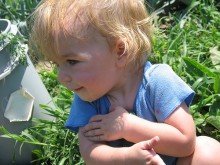Bel' bambino is the expression used to say 'beautiful child' when directed at a boy, or bella bambina for a girl. Both phrases are often preceded by the word che corresponding to 'what a...'
To say 'beautiful child' in Italian, you would generally use the word bella or bello, dependent on gender, or the superlative bellissimo or bellissima.
This is followed by the Italian word for child, which can be either bimbo or bambino (bimba or bambina fo r girls).
Bimbo or Bambina?
Whilst the English language comfortably groups the concept of 'children' into one word, Italians are more particular and commonly distinguish between bimbo/bimba and bambino/bambina. Although both ultimately mean 'child', there are some subtle differences.
Bambino can be used as both a male noun or as an adjective, whilst bimbo is strictly a noun.
Bambino can also be used in a number of circumstances - for instance it could simply refer to a young person, or to childish behavior (non fare il bambino means 'don't act like a kid') or even to the overall 'age of being a child'.
Bimbo is more commonly associated with toddlers because it has more of a loving, cuter aspect, and is most often used by mothers referring to their young children. One place where you will see the word bimbo widely used is on the Italian equivalent of the 'baby on board' signs displayed on the back of cars to remind fellow motorists to exercise caution while driving.
Bel' or Bella
Another thing to watch out for is that the adjective bello can be modified depending on the gender and person of the noun following it, as well as whether this noun begins with a vowel or not. For example the expression "What a beautiful child!" directed at a boy would be 'Che bel' bambino!', whilst directed at a girl it would be 'che bella bambina!'

